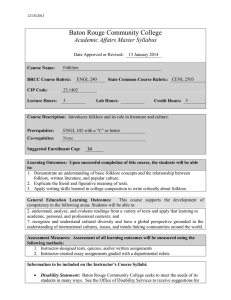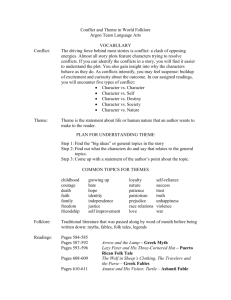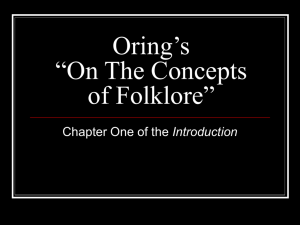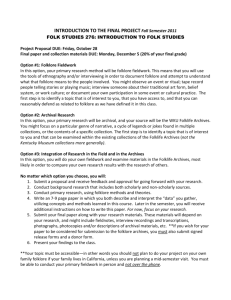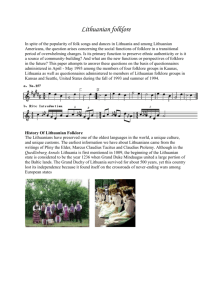Folk Computing: Revisiting Oral Tradition as a Scaffold for Co-Present Communities
advertisement
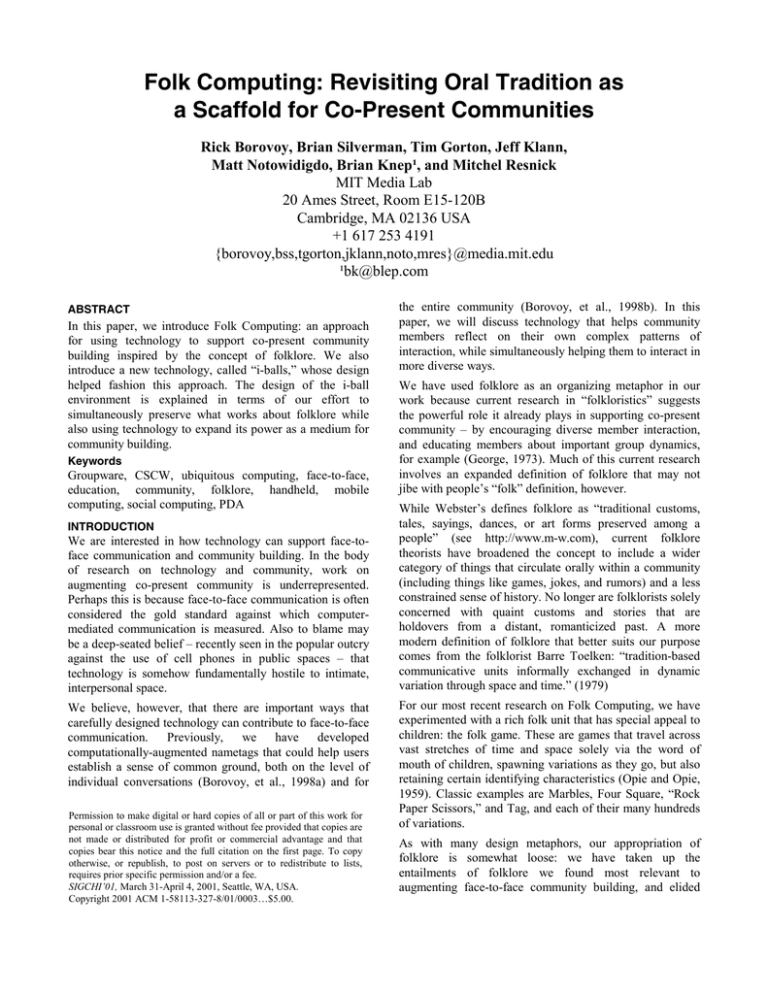
Folk Computing: Revisiting Oral Tradition as
a Scaffold for Co-Present Communities
Rick Borovoy, Brian Silverman, Tim Gorton, Jeff Klann,
Matt Notowidigdo, Brian Knep¹, and Mitchel Resnick
MIT Media Lab
20 Ames Street, Room E15-120B
Cambridge, MA 02136 USA
+1 617 253 4191
{borovoy,bss,tgorton,jklann,noto,mres}@media.mit.edu
¹bk@blep.com
ABSTRACT
In this paper, we introduce Folk Computing: an approach
for using technology to support co-present community
building inspired by the concept of folklore. We also
introduce a new technology, called “i-balls,” whose design
helped fashion this approach. The design of the i-ball
environment is explained in terms of our effort to
simultaneously preserve what works about folklore while
also using technology to expand its power as a medium for
community building.
Keywords
Groupware, CSCW, ubiquitous computing, face-to-face,
education, community, folklore, handheld, mobile
computing, social computing, PDA
INTRODUCTION
We are interested in how technology can support face-toface communication and community building. In the body
of research on technology and community, work on
augmenting co-present community is underrepresented.
Perhaps this is because face-to-face communication is often
considered the gold standard against which computermediated communication is measured. Also to blame may
be a deep-seated belief – recently seen in the popular outcry
against the use of cell phones in public spaces – that
technology is somehow fundamentally hostile to intimate,
interpersonal space.
We believe, however, that there are important ways that
carefully designed technology can contribute to face-to-face
communication.
Previously,
we have developed
computationally-augmented nametags that could help users
establish a sense of common ground, both on the level of
individual conversations (Borovoy, et al., 1998a) and for
Permission to make digital or hard copies of all or part of this work for
personal or classroom use is granted without fee provided that copies are
not made or distributed for profit or commercial advantage and that
copies bear this notice and the full citation on the first page. To copy
otherwise, or republish, to post on servers or to redistribute to lists,
requires prior specific permission and/or a fee.
SIGCHI’01, March 31-April 4, 2001, Seattle, WA, USA.
Copyright 2001 ACM 1-58113-327-8/01/0003…$5.00.
the entire community (Borovoy, et al., 1998b). In this
paper, we will discuss technology that helps community
members reflect on their own complex patterns of
interaction, while simultaneously helping them to interact in
more diverse ways.
We have used folklore as an organizing metaphor in our
work because current research in “folkloristics” suggests
the powerful role it already plays in supporting co-present
community – by encouraging diverse member interaction,
and educating members about important group dynamics,
for example (George, 1973). Much of this current research
involves an expanded definition of folklore that may not
jibe with people’s “folk” definition, however.
While Webster’s defines folklore as “traditional customs,
tales, sayings, dances, or art forms preserved among a
people” (see http://www.m-w.com), current folklore
theorists have broadened the concept to include a wider
category of things that circulate orally within a community
(including things like games, jokes, and rumors) and a less
constrained sense of history. No longer are folklorists solely
concerned with quaint customs and stories that are
holdovers from a distant, romanticized past. A more
modern definition of folklore that better suits our purpose
comes from the folklorist Barre Toelken: “tradition-based
communicative units informally exchanged in dynamic
variation through space and time.” (1979)
For our most recent research on Folk Computing, we have
experimented with a rich folk unit that has special appeal to
children: the folk game. These are games that travel across
vast stretches of time and space solely via the word of
mouth of children, spawning variations as they go, but also
retaining certain identifying characteristics (Opie and Opie,
1959). Classic examples are Marbles, Four Square, “Rock
Paper Scissors,” and Tag, and each of their many hundreds
of variations.
As with many design metaphors, our appropriation of
folklore is somewhat loose: we have taken up the
entailments of folklore we found most relevant to
augmenting face-to-face community building, and elided
others that did not suit our purposes. That being said, we
believe we have stayed true enough to the concept to
warrant our use of the term “folk” in the name of our
research project.
As an example of how we have worked within and around
the concept of folklore, consider how Folk Computing’s use
of communication technology appears to contradict the
centrality of pure, oral communication in folklore. In fact,
traditional folklore has often had a material dimension to it.
Many folk games, for example, make use of objects such as
balls and paper. The key is that these materials are nearly
ubiquitous and are easy to incorporate into face-to-face
interaction. Therefore, in our research, we have worked to
insure the technology has these qualities.
DESIGNING I-BALLS
This paper will focus on our most recent “folk computing”
development: the key-chain-sized “i-ball” devices. We will
explore our design and initial testing of the i-balls in terms
of how they preserve and extend the features and functions
of traditional folklore. It is important to note, however, that
over the last five years of folk computing development, the
role of folkloristic ideas in our designs has coevolved with
our technology and our experience of its potential. We try
to bring the prescriptions of theory, the possibilities of
technology, and the practical demands of actual
communities into a dialogue. Therefore, the following
design discussions should not be read as linear reductions
from theory to practice.
form of i-ball consists of a single “animation” programming
block. This block allows kids to “decorate” their i-ball by
composing an animation out of 128 different letters and
icons in a simple “flip-book” style animation editor. Figure
2 shows the first frame of an animation a child created that
depicts a face that blinks and says “hi”. I-balls created on a
PC can then be downloaded to an i-socket via a small
“docking station”.
Like the play objects they are named after, i-balls can be
passed between people. Participants can give a copy of one
of their i-balls to someone else, or, using “jump” blocks and
“rule” blocks in authoring environment, i-balls can be
programmed to “bounce” from one person’s i-socket to
another’s, based on user-defined rules. I-ball passing can
occur when two people connect their i-sockets using the
ports that SEGA designed in to the hardware. Figure 3
shows two kindergarteners passing an i-ball in this manner.
Figure 3. Two Children Exchange I-Balls
Figures 1 & 2. I-Ball and PC-based I-Ball Editor
Overview of I-Ball Design and Initial Trials
The name “i-ball” is short for “ball of information.” I-balls
are simple software folk objects that have some toy- and
game-like qualities. People can design their own i-balls and
then share with other members of community. In our
prototype, i-balls exist on key-chain-sized video game
devices made by SEGA and sold as part of their DreamCast
video game system, as shown in Figure 1. We wrote our
own software for this commercial device, and renamed it
the “i-socket,” to distinguish its capabilities from those of
the original SEGA “Visual Memory Unit (VMU)”–
designed to let kids store and recall their state in a
particular DreamCast game.
People design their i-balls on a PC using a prototype
graphical programming tool we developed. The most basic
We pilot tested the i-ball technology in the Fall of 1999 at a
multi-generational conference on “learning through
invention,” where almost all of the 500 children and adults
in attendance were given an i-ball device to wear around
their necks. In the Spring of 2000, we did a more extensive
trial over three weeks involving the entire third through
eighth grades of a public K-8 school – 350 students,
teachers, and staff members (including the principal,
secretary, cafeteria monitor, etc.)
A few words about how this new technology was received
and what kids did with it: At the first i-ball event, several
people commented on the frenzy that the activity
engendered. We had set up seven i-ball programming
kiosks, and they were in constant use, usually with several
people waiting behind each one. In a day and a half, more
than 1600 i-balls were created – an average of more than
three per attendee. The sight of participants passing i-balls
from i-socket to i-socket was ubiquitous.
Over the course of our i-ball trials, children have created iballs in a variety of “genres”, including:
•
“Hot potatoes” that must be passed according to certain
rules in a certain amount of time
•
“Quests”, or scavenger hunts, that send a person in
search of a variety of other people who meet particular
descriptions
•
“Randomizers” that were used to create “Magic 8
Ball”-type fortune teller toys
•
“Hitchers” that are simple autonomous software
“agents” that hitch-hike around the community, invisibly
jumping from one user to another
•
“Secret i-balls” that would show one animation to an
“insider” group (e.g. students) and another when viewed
by everyone else (e.g. teachers).
•
“Multi-author i-balls” that children would add their
own piece of animation to and then pass on
Designing I-Balls as Folklore
The ultimate goal was to use technology to expand the
capacity of folklore to build community. However, our first
challenge was to ensure that the i-ball technology preserved
enough of the essential characteristics of traditional folklore
for it to function that way. In fact, this emphasis on both
tradition and innovation is one of the hallmarks of folklore
itself (Toelken, 1979). Our attempts to design the i-balls to
satisfy this and other folklore requirements are the focus of
this section.
Designing for Folklore Habitat
The performance and exchange of folklore, particularly
children’s folk games, happens “in the wild.” (Opie and
Opie, 1959). Folk games thrive in the spaces of children’s
lives that still lie outside the encroaching boundaries of
adult structure and supervision. We chose the SEGA VMU
technology because its small size, durability, and built-in
connectivity gave us confidence it would find its way into
the kind of hallway and back-of-the-school-bus interactions
where children’s folklore plays such an important role (see
Figure 4).
quite smoothly, our team felt there was a little less
enthusiasm than we expected based on the previous trial.
However, as we walked past the school playground on our
way to lunch, we noticed that in the midst of kids playing
ball, there were a large number of children excitedly
showing each other i-balls they had made or collected.
When we stopped to observe, one child ran up to show one
of us a particular i-ball, saying “Have you seen this one?
It’s famous!”
That the i-ball activity did not take hold until kids played
with it “off the grid” is a sign of its success as folklore. As
the trial went on, we continued to witness and hear about iball interactions in the cafeteria, the teacher’s lounge, and
even the bathroom, known to be a key oasis for children’s
folklore in the school environment (Mergen, 1999).
One difficult trade-off: Because we wanted the i-socket to
be small enough for kids to wear, it was not large enough to
support an i-ball authoring tool. We had to separate the
playing and passing of i-balls from their authoring. This
was unfortunate, and it had consequences for meeting the
requirement that folklore blend both tradition and
innovation (see below).
Designing for Folklore Transmission
A key aspect of folklore is the seeming ease with which it
spreads through a community via face-to-face exchange.
Therefore, we designed the i-balls with ease-oftransmission in mind.
Children’s folk games often involve two levels of passing:
the games themselves get passed along from one child to
another, and passing can be an intrinsic part of the game.
For example, different variants of the ball game “Four
Square” are taught child to child, and the game itself
involves the passing of a ball between children. Tag is a
more abstract example, where the designation of who is “it”
is passed from child to child. When a child teaches another
child a game, he or she passes a copy of the game; the
original child still knows how to play it. However, when a
child passes something within a game, like a ball, or the
condition of being “it”, the object usually moves from the
giver to the receiver.
Figure 5. A Simple Jumping I-Ball Program
Figure 4. Kids Sharing Their New I-Balls After Class
One of the highlights of the school i-ball trial came on the
first day. We started the day in the computer lab
introducing various classes to the i-ball authoring tool and
helping them create their first i-balls. While things went
We designed both levels of passing into the i-balls. To pass
an i-ball game, a user connects his i-socket to another’s,
selects “copy” from a menu, and then selects the i-ball they
want to copy. To create an i-ball game that involves
passing, the user adds a “jump” block into his or her
program. For example, when the i-ball program shown in
Figure 5 executes, it will start at the left-most “start” block,
play through the following animation block showing a
character boarding a plane, and then wait for the user to
connect with another i-socket. At that point, the program
jumps over to the new i-socket, deletes itself from the old isocket, and continues executing after the jump block. It
immediately hits a “restart” block, causing the whole
program to repeat on the new i-socket.
Computationally, “jump” is a very complex operation.
Designing it as a primitive let children construct many
kinds of i-ball passing games with relative ease.
Designing for Conservatism and Dynamism
Toelken calls conservatism and dynamism “the twin laws of
folklore process” and says that “constant change, variation
within a tradition [is] a central fact of life for folklore”
(1979).
We wanted to support the kind of “variation within a
tradition” that one witnesses in such folk games as Marbles
or Tag. This meant that people should be able to dock their
i-socket to a PC, open up an i-ball they were passed whose
functionality they admired, tinker around with the program
in the i-ball editor, and then save this modified version back
to their i-socket. We imagined this would enable people to
easily make variations of popular i-balls without having to
understand their workings enough to rebuild them from
scratch.
At the school, more than one third of all i-balls created were
mutations of other already-existing i-balls, suggesting that
this capability was useful. Some i-balls inspired multiple
generations of mutations. Figure 6 shows a visualization of
how one i-ball mutated, where the original is in the center,
the mutations on it are in the surrounding ring, mutations on
mutations are in the next ring, and so on.
Ultimately, there were 98 different i-balls that had at least
one mutation on them where someone other than the i-ball’s
original author used that i-ball as the basis for a new one of
his or her own. These i-balls were much more numerous
than the half-dozen sample i-balls people used in the initial
trial, they represented a broader range of authors, and they
were part of an open system where anyone at any time
during the trial could create an influential i-ball on which
many people made variants. This was more in keeping with
the decentralized nature of folklore.
Sjors
Eli ’s
them
Sangjun
Since we could not support mutation, we offered instead a
set of editable sample i-balls for people to use to get started.
However, upon review of all the i-balls authored at the
conference, we were unhappy with the amount of influence
these somewhat arbitrarily chosen i-balls had. This risked
putting us in violation of another key folklore requirement:
what constitutes legitimate folklore does not get determined
by some central authority (Oring, 1986).
After implementing whole new client-server architecture for
the i-ball editors, we successfully added mutation capability
for the second i-ball trial at the K-8 school. Now, when a
student at a PC selected an i-ball on their i-socket to edit, a
copy of the uncompiled source code was transparently
uploaded from a central server. This meant that editable iball source code did not consume any of the precious isocket to i-socket communication bandwidth.
Sangjun
hquest
’s
’s
hquest
Jason
Sjors
squest
’s
’s
Ultraq#4
Bryce
UltraQs
Eli ’s
lukas
’s
t
Sjors
squest
Jason
’s
Eli ’ s
hquest
’s
squest
T i m ’s
m
m
Ziwei
freed
& m s
T im ’s
& m s
Eli ’ s
hquest
’s
Sangjun
hquest
Jhuana
Sacia
T im ’s
m
’s
Bryce
John
Julian
hquest
’s
Helen
hquest
UltraQst
Reva
Kush
’s
’s
Kush
A Quest
Najma
broken-VMU
’s
Sjors
hquest
Sacia
Fekadu
Sports
Fekadu
Sports
Helen
hquest
’s
’s
Najma
hquest
C am ar a
hquest
’s
Natercia
Jutin
’s
’s
’s
Fekadu
hquest
’s
squest
broken-VMU
’s
Helen
hquest
’s
Akiana
adventur
hquest
’s
Reva
hquest
Reva
hquest
Akiana
’s
’s
Q
’s
female
Jhuana
hquest
John
hquest
s
’s
Alex
hquest
’s
’s
’s
Philippa
’s
hquest
Jhuana
hquest
Philippa
so fin
Jhuana
Leandra hquest’ s
hquest
’s
e
’s
John
hquest
’s
’s
Natasha
Helen
Kush
Natasha
Alex
alex
’s
Q
John
Aquest
’s
’s
Sacia
squest
’s
hquest
Reva
Kquest
’s
Eli
’s
Joel
Dara
’s
D ar a J
Sjors
hquest
Z i w e i ’s
hquest
broken-VMU
hquest
’s
broken-VMU
’s
broken-VMU
hquest
’s
’s
Kush
Kquest
Joel
hquest
Kush
hquest
Jhuana
hquest
’s
’s
Sjors
hquest
Graham
’s
hquest
’ s
Leia
’s
Lukas
hquest
Kush
Kquest
’ s
Natasha
hquest
Am y ’s
brain q.
Leia
hquest
Yuxin
hquest
’s
Noah
hquest
’s
A m y ’s
Sacia
’s
’s
Natercia
Jutin
’s
’s
broken-VMU
hquest
’s
Alex
’s
’s
hquest
’s
Eric
’s
hquest
’s
’ s
Lia
Lia
’s
Q
’s
hquest
’s my qest
Halima
’s
Lukas
hquest
hquest
’s
Jhuana
Mackendy
hquest
Dara
’s
D ar a Q
Jarvis
’s
J QU E S T
brain q.
hquest
’s
Noah
hquest
’s
Jhuana
’s
hquest
Sports
Kush
Kquest
hquest
Yuxin
’s
’s
kquest
’s
Eric
’s
’s
Helen
hquest
’s
’s
’s
Q
’s
Philippa
hquest
hquest
’s
’s
Reva
hquest
’s
hquest
Philippa
Kush
’s
hquest
Kquest
’s
Najma
hquest
Jason
alex
’s
hquest
hquest
’ s
hquest
’s
’s
9
Fekadu
Sports
Jason
alex
’s
hquest
hquest
Najma
hquest
Kush
Fekadu
’s
Natasha
’s
hquest
’s
’s
hquest
Philippa
’s
Helen
hquest ’ s
hquest
Ziwei
’s
’s
’s
’s
’s
broken-VMU
Jhuana
hquest
hquest
Leia
’s
kewlques
hquest
Fekadu
hquest
Najma
hquest
’s
’s
hquest
broken-VMU
Matt
hquest
Helen
hquest
’s
Gilberto
’s
Sports
’s
broken-VMU
hquest
’s
’s
’s
A m y ’s
ghost q.
’s
Fekadu
Natercia
’s
Jutin
Yuxin
hquest
Reva
hquest
’s
Julian
build
Ziwei
’s
Q
’s
’s
’s
brain q.
’s
’s
hquest
Eric
’ shquest
hquest
Alex
hquest
’s
hquest
’s
hquest
JarvisHelen’ s
hquesthquest
’s
Fekadu
hquest
Alex
’s
Alejandra
Super
’s
hquest
hquest
Fekadu
Sports
Reva
’ s
’s
Billy
Sjors
hquest
Lillian
Fekadu
Sports
’s
Sacia
’s
’s
Joel
’s
hquest
C a m a r a Natercia
’s
Jutin
hquest
’s
’s
Joel
hquest
hquest
Natasha
hquest
’s
’s
Helen
hquest
Eli ’ s
’s
hquest
broken-VMU
hquest
Yuxin
broken-VMU
hquest
’s
Am y
Helen
hquest
’s
Helen
hquest
’s
broken-VMU
hquest
broken-VMU
hquest
’s
Adelina
Amanda
hquest
Kush
hquest
hquest
’s
Z i w ei ’ s
hquest
Phakamile
hquest
’s
hquest
’s
’s
hquest
’ s
’ s
Jutin
hquest
’s
’s
e
’s
’s
hquest
Philippa
Fekadu
hquest
Reva
hquest
Reva
Julian
Natercia
’s
Helen
Najma
hquest
Eli ’s
hquest
Reva
hquest
’s
Fekadu
Sports
Fekadu
hquest
’s
’s
Yuxin
Z i w e i ’s
hquest
’s
Leia
’s
hquest
’s
hquest
Helen
Lukas
my qest
’s
’s
’s
Z i w ei ’ s
hquest
Sacia
squest
’s
’s
Jhuana
hquest
Kush
Kquest
’s
squest
Natasha
’s
’s
’s
Sacia
’s
hquest
Susanna
hquest
squest
’s
broken-VMU
hquest
Yuxin
hquest
Philippa
hquest
Helen
’s
Philippa
so fin
Sjors
hquest
Caleb
’s
broken-VMU
hquest
hquest
’s
Sjors
squest
’s
’s
’s
hquest
’s
’s
hquest
Natalie
hquest
’s
Z i w e i ’s
T im ’s
fre e
1470
Fekadu
Sports
Reva
Caleb
hquest
hquest
’s
Kquest
Akiana
’s
hquest
broken-VMU
hquest
Philippa
hquest
Kquest
Kush
hquest
’s
’s
’s
hquest
A m y ’s
brain q.
T im ’s
m & m s
’s
’s
hquest
squest
& m s
broken-VMU
hquest
Due to a design trade-off, we were not able to get this
“mutation” support implemented for the first i-ball
conference trial. Communication between two connected isockets turned out to be fairly slow. We limited i-ball size
to 512 bytes to ensure i-balls could be passed quickly
enough to keep passing games lively and to keep i-ball
exchanges spontaneous. The 512-byte limitation already
constrained the amount of animation and behavioral
complexity each i-ball could exhibit. Making an i-ball “decompilable” – able to be uploaded from an i-socket and
restored to user-editable form – would have required
sacrificing more i-ball expressiveness in the service of
background plumbing.
’s
squest
Natercia
Jutin
’s
broken-VMU
hquest
’s
Lia
Lia
Dara
’s
D ar a t
’s
Eric
’s
Q
’s
hquest
Fekadu
Sports
’s
Fekadu
Sports
’s
Fekadu
’s
Sports
Fekadu
Sports
Eric
’s
hquest
’s
Blake
’s
D ar a t
Jarvis
’s
J QU E S T
Noah
sexy
’s
Jesse
J ESSE
’s
Q
Jesse
J ESSE
Jesse
J ESSE
Jesse
J ESSE
’s
Q
Jesse
J ESSE
’s
Jesse
J ESSE
’s
Q
’s
Q
’s
Q
Q
Figure 6. Mutation Visualization of an Influential I-Ball
(See color plate on page 000)
Adding New Dimensions to Folklore
The previous section focused on our efforts to preserve the
salient features of folklore in our i-ball design. This section
focuses on two new capabilities, tracking and computational
agency, which we designed into the i-balls in an effort to
enhance their effectiveness as a medium for community
building.
Tracking and Social X-Rays
Many folklore scholars are interested in the role folklore
plays in educating members of its community, or “folk
group.” We are particularly interested in the role folklore can
play in educating a community about the community. As
Toelken says “one of the key features of a folk group will
always be the extent to which its own dynamics continue to
inform and educate its members and stabilize the group”
(1979). We believe that, using technology, we can
significantly improve the extent to which a folk group’s
dynamics can inform and educate its members.
Like dye that is injected into a vein in order to reveal the
internal structures of one’s body on an x-ray, the i-balls were
designed as kind of dye that flows through a group and
reveals images of its social structure, or “social network”
(Scott, 1991). Each i-ball has the built-in ability to store its
own path as it moves from person to person, and to report this
path back to a central server every time its host i-socket
comes in contact with a PC. Participants can then access this
data through a suite of visualizations we designed to
illuminate relevant community dynamics.
Figure 7 shows a type of visualization that reveals how a
particular i-ball moved through the school population. Each
node is a person, labeled with their first name and grade. The
creator of the i-ball is the root node. Each link represents an
exact copy of the i-ball that was given from the person above
to the person below (for details on the color scheme, see
below). The tool was designed so that students could pull up
a visualization of this sort for any i-ball they currently had on
their i-socket, or for any i-ball they created.
Students’ immediate reaction to these types of diagrams was
fascination. Because many of the computers at the school
were quite slow at creating these images, we printed several
poster-sized versions of them for popular i-balls. When a new
one was put up, kids would swarm around it, first trying to
locate themselves on this representation of their social terrain,
and then looking to see how their friends and classmates were
tied in. There was a sense of excitement around this
privileged view these students were getting of a geometry
they always sensed, but could never before directly
apprehend. And this geometry was personal: we observed one
girl become quite upset when she could not find herself on a
chart for an i-ball she was sure she had received.
Some kids, on further reflection, were able to make more
sophisticated interpretations of the visualizations. One sixthgrade boy carefully explained to us that you couldn't tell how
cool an i-ball was just by how many people got it. Instead,
you had to look at the pattern of how the i-ball moved. If the
author gave the i-ball to a number of people, that was much
less cool than if he gave it to a few people, and they gave it to
a few people, etc. We saw in this the seeds of a more
sophisticated model of that ubiquitous and problematic
adolescent concept of “popularity".
We witnessed several occasions where viewing these
visualizations
helped
students
surface
powerful
misconceptions. For example, one girl, when viewing a list of
who had gotten a copy of an i-ball she authored, exclaimed,
“How did she get a copy of my i-ball? I didn't give it to her. I
don't like her!” Only after viewing the i-ball movement tree
did she realize that a friend of hers gave it to this other girl,
and that it wasn't just about who she gave her i-ball to
directly. The notion that she could be linked to an enemy
through a friend was unsettling to her.
One of the most interesting “ahas” came after a third grade
class viewed a visualization of how one of their favorite iballs had spread. Someone in the class had made an i-ball
version of the class mascot: a bunny named Shadow. They
felt this i-ball was very popular and asked several times for a
poster-sized printout of how it traveled through the school.
When we brought it to their class, however, they were
disappointed.
The visualization revealed that while most of the third-grade
had gotten a copy of the Shadow i-ball, it had not spread
much beyond that. After a long discussion, it became
increasingly clear that the third grade had come to believe
that because everyone in the class had seen Shadow, many in
the school probably had as well. This led to some interesting
conversation about the limits of generalizing what is true
about your close-knit group to what is true about the larger
population.
Ordinarily, of course, the mistaken beliefs of the third graders
are self-sealing. People’s folklore universe is determined by
whom they interact with, and there is no way of getting
outside this universe to test the limits of it. Phenomena like
insularity are notoriously hard to see from the inside. The iball visualizations provide a potential way out, however.
With them, kids could begin to see how the structure of their
social networks informed their view of the world.
Our original version of the type of graph depicted in Figure 7
was not “colorized”. Instead, students had to study the text in
each node to discover the characteristics of the person it
represented, and then look for patterns in how these nodes
were connected. In an effort to make community interaction
patterns “pop out” at the viewer, we added the colorizing
functionality. For example, the visualizations in Figures 7 and
8 make gender and grade insularity easily discernable by
colorizing the nodes according to these attributes. People
tended to pass the “Romance” i-ball to others of the same
gender and in the same grade. Interestingly, Figure 9 reveals
no comparable insularity with respect to ethnicity.
Kids have a natural interest in probing the social network that
binds them together. We see this in some traditional folk
games that involve simpler forms of the kind of tracking we
built into the i-balls. For example, kids write chain letters in
hopes of receiving back postcards that signify their
connection to children all over the world. Unfortunately, this
feedback channel is very brittle, and the postcards almost
never arrive.
In an effort to make the feedback more reliable, kids play the
game of “Telephone” while sitting around a table. One person
whispers something to his neighbor, who then repeats it to her
neighbor, and so on until the message has gone all the way
around the table. At this point, the last person and the first
person say what they believe the message to be, and
everybody laughs at how it was transformed by the oral
process. What is Telephone if not a tabletop experiment
designed by kids to explore their own oral culture? I-balls let
kids move these experiments off the tabletop and into the
wild, where folk culture really lives.
Figure 7: Visualization of How the “Romance” I-Ball Traveled, Colored by Gender (See color plate on page 000)
Figure 8: Visualization of How the “Romance” I-Ball Traveled, Colored by Grade (See color plate on page 000)
Figure 9: Visualization of How the “Romance” I-Ball Traveled, Colored by Ethnicity (See color plate on page 000)
Computational Agency and Community Integration
In both i-ball trials, we received a large amount of positive
feedback for the role the i-balls played in both integrating
strangers into a community, and in helping people interact
beyond their usual social sphere. In the survey results from
the first trial, several parents expressed their gratitude for
the way the i-ball activity drew out their otherwise shy
children, encouraging them to interact more with other kids
and even making them comfortable interacting with other
adults. At the conclusion of the school trial, one teacher
discussed some difficulties that the school community
experienced recently, and said she felt the i-ball activity had
a very healing influence. Folklore is already understood to
play this type of “integrative” role in communities (George,
1973). However, a specific capability of the i-balls made
them much more effective at this task.
We believe that the computational agency inherent in the iballs made them especially helpful for community
integration. To best explain this, we need to explain the
“killer app” of the i-ball activity – The Quest.
Figure 10. Part of a Quest I-Ball Program
Figure 10 shows the last several program blocks for a
popular quest i-ball that was written by one of the
schoolteachers. Quests work by displaying an animation – a
simple text messages in the example – that instructs the
player to go seek out someone else of a particular
description. The program then halts at a “wait” block that
contains a condition that must be met before the program
continues and the next animation clue is displayed. In
Figure 10, notice that the middle clue says “Find someone
who likes tennis.” The next block is a wait block that
contains a condition requiring the person playing the quest
i-ball to connect his or her i-socket to the i-socket of
someone whose favorite sport is tennis.
with a pop-up list of substitutions. In the figure, the author
is choosing to have the quest player search for someone
who likes tennis instead of some other support. Other
conditions particular to other variables can be added, and
these conditions can be and'ed or or'ed together. We chose
the variables in advance (age, grade, gender, favorite sport,
etc), and got the data into everyone’s i-socket by way of a
web form they filled out before the activity started.
Quests were wildly popular. One of the signature events
that was repeated over and over again at both i-ball trials
was one person approaching someone else and saying
something like “Do you have brown eyes and like
broccoli?” The quest in Figure 10 that the teacher made
spread to hundreds of people at the school, and inspired 48
different mutations.
The crucial feature of the quest was the way it invited,
almost demanded, that a player interact with a variety of
people. Because of the agency exhibited by the quest – it
instructed you on whom to meet, it could tell when you had
done it, it could control the flow of information, and it
could even impose a time limit – participants seemed to feel
comfortable approaching people they ordinarily wouldn't.
They had an alibi: “The quest made me do it!”
Because of power quests had over people’s behavior, quest
authors were inclined to try design quests that brought
people together in unusual ways, or ways perceived as
helpful. For example, at the school, one parent and child
authored a “thank you” quest that sent people to find
teachers, staff, and students who the authors felt had been
unrecognized for their community contributions. Of course,
quest authors and quest players were the same people.
Many people both designed quests and played the quests of
others. Therefore, one can look at the quest as a way for a
community to regulate its own patterns of interaction.
Although some of the interactions surrounding quests were
superficial, there was some evidence that they laid the
groundwork for more meaningful interactions. One
participant at the conference commented that once one had
discussed someone’s favorite food with them, it was easier
to talk to that person later about something more
substantive. Of course, this is one of the points of folklore;
although the lore itself might not be that meaningful, the
connections that it maintains and the sense of group identity
it forges create a context for more meaningful interaction.
PRIOR WORK
Figure 11. I-Ball Rule Editor
Figure 11 shows how the quest author spells out this
condition in the i-ball editor. Basically, a condition
template is provided where each element can be altered
There are two major ways our research on Folk Computing
devices differs from other technology to support community
building: its emphasis on co-present, not distributed,
communities and its emphasis on augmenting community
context, not content.
The relatively small amount of work that is being done in
the area of co-present community support often uses the
technology to help mediate the dominant conversation, such
as tools for meeting support (Stefik et al, 1987). We take
another approach by supporting a kind of background
communication that is larger in scale than any one focused
meeting. The bits of folklore that move through this
channel do not represent the main thread of any
conversation, but instead help establish a shared community
context.
Our work on “Meme Tags” (Borovoy, et al., 1998b),
computationally augmented nametags, had several qualities
in common with the i-balls. People could author their own
short, textual ideas (or “memes”), trade them with their
peers, and then track how they were circulating via largescreen “Community Mirrors.” Some of the i-ball design
grew out of our disappointment with people’s lack of
interest in purely textual memetic content. Memes did not
spread very widely or generate much community “buzz”.
This was in stark contrast to the more richly structured iballs, some of which spread through most of the school, and
did indeed become “famous.” The i-balls also introduced
the “mutation” capability into the authoring tool and
visualizations.
Tools are starting to appear that produce visualizations of
the social networks of online communities by parsing their
email or Usenet messages (for example, see Sack, 2000).
These tools differ from the i-ball visualizations in their
focus on on-line, rather than face-to-face, interaction.
People often compare our work on the i-balls to Pokemon
(see http://www.pokemon.com), a hand-held video game
that involves some trading of creatures back and forth
between kids. Pokemon is missing two elements that are
essential to the Folk Computing concept, however:
authoring and tracking. Kids play very little role in the
creation of the Pokemon creatures. Instead, there is a closed
universe of a few hundred kinds. Also, when kids give their
creatures away, they have no idea what happens to them.
Authoring, passing, and tracking are tightly integrated in the
Folk Computing concept. The ability to pass on their
creations motivated people to spend a lot of time designing
interesting i-balls. The fact that they had authored the iballs themselves meant they cared about where they went
and who had them. Finally, the fact that they experienced
what it was like to pass a single i-ball to someone else
meant they had an entrée into the understanding of complex
visualizations with hundreds of links. This combination is
unique.
CONCLUSION
While some of our most meaningful interactions happen in
face-to-face settings, technology has yet to play a large role
in supporting co-present communities. We have drawn
inspiration from the role folklore plays in building and
sustaining these communities, and have patterned a new
generation of personal devices on folkloric features and
processes. In this paper, we have documented the struggle
to both preserve key dimensions of traditional folklore, as
well as add new computational features that extend its
community-building power.
In future research, we would like to conduct a careful
ethnographic study of how Folk Computing devices get
used by communities. Unfortunately, there is a constant
trade-off between the effort required to design, build, and
maintain this technology, and the effort required for careful
study of how technology gets used. We are on the lookout
for the right collaborators to ease this trade-off.
ACKNOWLEDGEMENTS
This project was funded in part by Motorola and the Things
That Think Consortium at the MIT Media Lab. Intel,
SEGA, and Tom Sawyer Software also made generous inkind contributions. Thanks also to Espedito Rivera, Dr.
Sybil Knight, Carol Stoeber, Alice Yang, Chris Lyon, Jan
Malasek, and Dr. Fred Martin for their amazing talents and
good will.
.
REFERENCES
1. Toelken, B. The Dynamics of Folklore. Houghton
Mifflin Company, Boston, 1979.
2. Opie, I. and Opie, P. The Lore & Language of School
Children. Oxford University Press, London, 1959.
3. George, P. The Folk Legend. In Introduction to
Folklore, Collegiate Publishing, Inc., Columbus, Ohio,
1973.
4. Borovoy, R., Martin, F., Resnick, M., and Silverman, B.
Name tags that tell about relationships, in CHI ’98
Summary (Los Angeles, CA, 1998a), ACM Press.
5. Borovoy, R., Martin, F., Vemuri, S., Resnick, M.,
Silverman, B., & Hancock, C. Meme tags and
community mirrors: Moving from conferences to
collaboration, in Proceedings of the 1998 Conference
on Computer Supported Cooperative Work (Seattle,
WA, 1998b), ACM Press.
6. Mergen, B. Children’s Lore in School and Playgrounds.
In Children’s Folklore: A Source Book, Utah State
University Press, Logan, Utah, 1999.
7. Oring, E. On the Concepts of Folklore, in Folk Groups
and Folk Genres: An Introduction. Utah State
University Press, Logan, Utah, 1986.
8. Scott, J. Social Network Analysis: A Handbook. SAGE
Publications, London, 1991.
9. Stefik, M., Foster, G., Bobrow, D. G., Kahn, K.,
Lanning, S., and Suchman, L., Beyond the Chalkboard:
Computer Support for Collaboration and Problem
Solving in Meetings, Communications of the ACM 30,
No. 1, 32-47, 1987.
10.
Sack, W. Conversation Map: A Content-based Usenet
Newsgroup Browser, in Proceedings of the ACM
International Conference on Intelligent User Interfaces
(New Orleans, LA, 2000), ACM Press.

